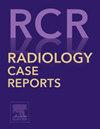主动脉根置换术后冠状动脉支架植入术
Q4 Medicine
引用次数: 0
摘要
我们报告一例29岁男性在主动脉根置换术后1个月出现严重冠状动脉狭窄的病例。患者表现为运动性胸痛,并发展为长时间静息性心绞痛和室性心律失常。心电图显示缺血改变提示左冠状动脉受累,多层计算机断层血管造影证实左主干(LM)分叉次全狭窄。紧急经皮冠状动脉介入治疗(PCI)与药物洗脱支架植入从LM到左前降支使用临时技术,导致左心室射血分数从23%提高到55%。患者出院时无并发症,随访6个月无事件发生。本病例强调了ARR后一种罕见但可能危及生命的冠状动脉并发症,其可能与灌注插管放置,冠状动脉口再植术中的技术因素或主动脉假体或明胶-间苯二酚-甲醛胶的增殖反应有关。它强调了早期识别和警惕ARR后冠状动脉缺血的必要性-即使是没有冠状动脉疾病的年轻患者-并强调了急诊PCI的疗效。建议采用多学科方法来优化复杂的心血管术后患者的预后。本文章由计算机程序翻译,如有差异,请以英文原文为准。
Coronary stenting after aortic root replacement
We describe a case of severe coronary artery stenosis in a 29-year-old male 1 month after aortic root replacement (ARR). The patient presented with exertional chest pain that progressed to prolonged resting angina and ventricular arrhythmia. Electrocardiography showed ischemic changes suggestive of left coronary artery involvement, and multislice computed tomography angiography confirmed subtotal stenosis at the left main (LM) bifurcation. Urgent percutaneous coronary intervention (PCI) with drug-eluting stent implantation from the LM to the left anterior descending artery was performed using a provisional technique, resulting in improvement of left ventricular ejection fraction from 23% to 55%. The patient was discharged without complications and remained event-free at 6-month follow-up. This case highlights a rare but potentially life-threatening coronary complication after ARR, which may be related to perfusion cannula placement, technical factors during coronary ostial reimplantation, or proliferative reactions to the aortic prosthesis or gelatin–resorcinol–formaldehyde glue. It underscores the need for early recognition and vigilance for coronary ischemia after ARR − even in young patients without prior coronary artery disease − and emphasizes the efficacy of emergency PCI. A multidisciplinary approach is recommended to optimize outcomes in complex postsurgical cardiovascular patients.
求助全文
通过发布文献求助,成功后即可免费获取论文全文。
去求助
来源期刊

Radiology Case Reports
Medicine-Radiology, Nuclear Medicine and Imaging
CiteScore
1.10
自引率
0.00%
发文量
1074
审稿时长
30 days
期刊介绍:
The content of this journal is exclusively case reports that feature diagnostic imaging. Categories in which case reports can be placed include the musculoskeletal system, spine, central nervous system, head and neck, cardiovascular, chest, gastrointestinal, genitourinary, multisystem, pediatric, emergency, women''s imaging, oncologic, normal variants, medical devices, foreign bodies, interventional radiology, nuclear medicine, molecular imaging, ultrasonography, imaging artifacts, forensic, anthropological, and medical-legal. Articles must be well-documented and include a review of the appropriate literature.
 求助内容:
求助内容: 应助结果提醒方式:
应助结果提醒方式:


